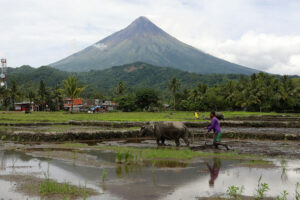By Kyle Aristophere T. Atienza, Reporter
AGRICULTURE OUTPUT likely grew in the second quarter after year-earlier production was held down by the El Niño, analysts said, adding that high-value crops like rice and corn are believed to have driven growth.
The second-quarter result also came in before consecutive tropical storms traversed the Philippines in July.
Federation of Free Farmers (FFF) National Manager Raul Q. Montemayor said via Viber that the second quarter data will reflect a “slight increase” because of base effects. The year-earlier result had been “relatively low” because of dry conditions resulting from El Niño.
“Crops may exhibit a slight rebound, while poultry will continue to be the lone bright spot in the agricultural sector,” he said.
The value of production in agriculture and fisheries at constant 2018 prices dropped 3.3% to P413.91 billion in the second quarter of 2024, with crops and livestock production leading the declines.
It was the biggest drop since the 3.4% contraction posted in the first quarter of 2021.
Former Agriculture secretary William Dar said via Viber that crops like vegetables likely performed in the second quarter because of favorable weather.
Corn and rice are believed to have driven growth in the crops sector, former Agriculture undersecretary Fermin D. Adriano said via Viber.
“Vegetable production will likely increase given good weather,” he added.
Crop output, which accounts for half of agricultural production, fell 8.6% year on year in the second quarter of 2024, with production of palay and corn declining 9.5% and 20.3%, respectively.
Sugarcane, onion, tomato, mung bean (monggo), and abaca also posted double-digit declines in production.
The Philippine Statistics Authority said last week that palay (unmilled rice) harvest may have increased 13.2% to 4.35 million metric tons (MMT) in the second quarter.
It said as of June 1, almost 90% of the 972,750-hectare standing crop was harvested, yielding palay output of 3.89 MMT.
Mr. Montemayor of the FFF said poultry likely continued to be the “lone bright spot” in agriculture in the second quarter.
“Poultry and fishery production might rebound again because of good weather compared to the same quarter last year when El Niño struck the country,” Mr. Adriano said.
Poultry output rose 8.7% year on year in the three months to June 2024, with chicken egg, chicken, duck, and duck egg production rising.
Fisheries output, meanwhile, rose 2.2% in the second quarter of 2024, a turnaround from the 13.8% decline a year earlier, amid gains in the catches of skipjack or gulyasan, bigeye tuna, yellowfin tuna, frigate tuna or tulingan, P. Vannamei, blue crab, fimbriated sardines, and cavalla or talakitok.
“The fisheries sub-sector will likewise post minimal growth,” Mr. Dar said.
The analysts said livestock output likely contracted in the second quarter of 2025.
“The piggery sub-sector continues to be posting dismal output due to the prevalence of the African Swine Fever (ASF),” Mr. Dar said.
Hogs account for 12.4% of livestock production.
The Food and Drug Administration has yet to approve a Vietnamese vaccine against ASF for commercial rollout, though Agriculture Secretary Francisco Tiu Laurel, Jr., said in late July that the first 150,000 doses of the AVAC have been distributed.
“Livestock will continue its downward trend due to the persistent spread of ASF,” Mr. Adriano said.
The Bureau of Animal Industry reported active ASF cases in 32 barangays across the country as of June 20, down from 64 a week earlier.
As of July 11, the number of affected barangays had declined to 28.
Livestock production fell 0.3% in the second quarter of 2024, reversing the 0.7% expansion a year earlier, led by weak goat, carabao, and hog production.






